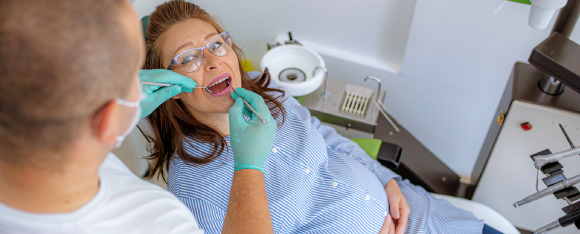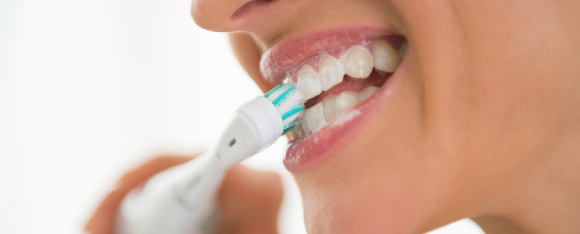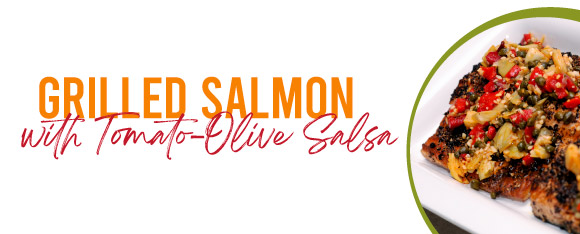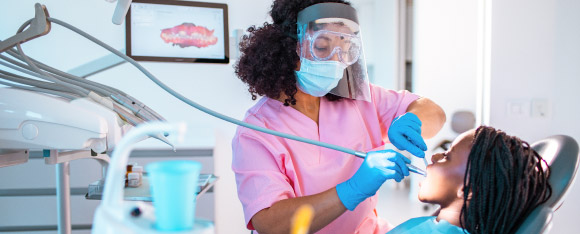

Baby your mouth during pregnancy
During your nine months of pregnancy, you’ll have lots of doctor appointments. While the thought of squeezing in the dentist might seem like a hassle, preventive visits are an important part of prenatal care.
To take the best care of your growing baby, you’ve got to take care of yourself. Being pregnant can increase your risk of getting gum disease, a condition that can harm your little one. Gum disease has been linked to complications like early labor and underweight babies.[1] But when caught in the beginning stages, gum disease can be reversed when treated by your dentist.[2]
If you notice tender, swollen gums that bled easily when brushing or flossing, you may have gum disease. It’s a good idea to talk with your dentist about what to do. A routine dental cleaning can be an effective first step in healing a case of mild gum disease. Many United Concordia Dental plans even cover an extra cleaning for expectant moms.
If your plan includes the Pregnancy Benefit, you can activate this extra coverage by signing into your MyDentalBenefits account. Go the Wellness tab, select New Condition and choose Pregnancy from the list.
Besides sticking to your regular dentist visits, make sure to take extra-good care of your mouth at home. Remember to brush 2-3 times a day and floss once. Sipping water during the day will also help rinse your teeth clean, plus keep you and baby well hydrated.

Inhalers can affect your oral health
If you have asthma, you probably use an inhaler to take your medicine. With an inhaler, you slowly draw the medicine into your airways. Unfortunately, many people don’t use inhalers the right way. So more medicine can stay in your mouth than get into your lungs.[3]
Several kinds of medicines are prescribed to prevent and control asthma. Inhaled steroids, or corticosteroids, are often used to reduce inflammation and help you breathe better. But inhaled steroids can cause side effects in your mouth, such as hoarseness, cough, sore throat and oral thrush.[4]
Thrush is a yeast infection that grows in the throat or mouth. Symptoms can include a white coating on your tongue; bleeding or painful bumps in your mouth; dry skin on the corners of your mouth; and a bad taste in your mouth.[4]
With treatment from a doctor, thrush typically gets better in about two weeks.[4] To prevent thrush, it helps to rinse your mouth with water after using your inhaler. Your doctor may also recommend adding an attachment called a spacer to your inhaler. A spacer snaps on to the end you breathe into and helps more medicine reach your lungs.
If you have asthma, try these tips to take the best care of your oral health and help prevent side effects.

Recharge your brushing routine
Up. Down. Up. Down. Up. Down.
Bored with manual brushing? An electric toothbrush can add zip – and extra cleaning power – to your daily routine.
Though manual toothbrushes work just fine, electric brushes can remove three times more plaque.[5] And they can clean so well, it’s like a month’s worth of brushing in just two minutes.[5]
Remember, an electric toothbrushes automatically does the cleaning action for you, so you don’t have to scrub back and forth. The proper technique is very different than with a manual brush.
How to use an electric toothbrush [5]
Imagine your mouth divided into four sections, two on the top and two on the bottom. Focus on one section for 30 seconds first, and then move on to the next. That way, you get the recommended two minutes of brushing in.
- Apply toothpaste and then wet the brush head. Turn it on when it’s in your mouth.
- Angle the brush along your gumline at 45 degrees. Gently slide the head along your gums, using only light pressure.
- Slowly glide the brush along the outside, tooth by tooth.
- Next move the brush along the inner surfaces, and then the biting surfaces.
- After 30 seconds, repeat these steps in the remaining three sections of your mouth.

A Mediterranean diet may help asthma
When you have asthma, your airways can get inflamed and become narrower.[6] That’s why it feels so hard to breathe during an attack.
When it comes to inflammation in your body, certain foods can either cause it or lessen it. For instance, a “Western” diet that’s high in fat, cholesterol, sugar and salt can lead to inflammation.[7] But a way of eating called the “Mediterranean” diet can actually help lower inflammation.[8]
The Mediterranean diet is based on the foods eaten in Greece and Italy. It became popular when researchers found that the people there had much less risk of heart disease.[9]
This healthy eating plan focuses on vegetables, fruits, whole grains, beans, nuts, seeds and olive oil. It also includes chicken and fish rich in omega-3 fatty acids like salmon, tuna and sardines.
What yummier way to try this diet than with grilled salmon topped with tomato-olive salsa?
Check out the recipe below.
Foods that fight inflammation[10]
• Tomatoes
• Olive oil
• Green leafy veggies (kale, spinach, collards and more)
• Nuts (such as almonds and walnuts)
• Fatty fish (salmon, mackerel, tuna, sardines)
• Fruits (strawberries, blueberries, oranges and cherries)

Grilled Salmon with Tomato-Olive Salsa
Serves 6
Ingredients:
1½ cups diced, seeded plum tomatoes (about 10 ounces)
6 tbsp. olive oil
12 Kalamata olives or other brine-cured black olives, pitted, chopped
¼ cup chopped fresh basil
2 tbsp. drained capers
2 large garlic cloves, minced
1 shallot, finely chopped
6 6-ounce salmon fillets
Directions:
Combine tomatoes, 4 tablespoons oil, olives, basil, capers, garlic and shallots in medium bowl; stir to blend. Season salsa to taste with salt and pepper. Refrigerate at least 15 minutes and up to 2 hours.
Prepare barbecue (medium-high heat). Brush salmon with remaining 2 tablespoons oil; sprinkle with salt and pepper. Grill until salmon is just opaque in the center, about 4 minutes per side. Transfer salmon to plates. Top with salsa.
Brought to you by epicurious

Could your heartburn be GERD?
Are you pregnant and having heartburn? Most moms-to-be feel symptoms at some point. But they could be a sign of something more serious—gastroesophageal reflux disease (GERD). Often called acid reflux, GERD can harm your oral health during the wait for your precious bundle of joy.
GERD forces stomach acid up into your mouth and can erode your tooth enamel. Without this layer of protection, teeth are open to bacteria, plaque and cavities.[11]
Other changes to your body during pregnancy can force acid upwards. Pregnancy hormones can cause the esophagus to relax more often. Your digestive system can slow down, and your uterus may push on your stomach[12]. The natural pH level in your mouth also becomes more acidic.
Chewing gum with xylitol, an all-natural sweetener, can reduce acidity. Rinsing with baking soda water after eating and using a neutral fluoride product daily also can help. Most over-the-counter antacids are also safe to take while your’re pregnant.
Common symptoms of GERD include difficulty swallowing, choking, coughing and throat clearing. You may have some—or none—of these symptoms. So keeping up with regular dental exams and cleanings is a must when expecting, especially during the second and third trimesters.[13] And don’t worry—if you do have symptoms, they usually improve once the baby is born!
Even if you’re not pregnant, you may be susceptible to GERD. The condition often goes undiagnosed, as many people don’t experience symptoms, so your dentist may be the first to notice these early signs.

Don’t be scared to go back to the dentist
Now that vaccines are rolling out, people are starting to feel comfortable getting out and back to life. While a fancy restaurant dinner sounds more fun than a routine dentist visit, the latter is an important engagement you should pencil back on your calendar.
The fact that no COVID-19 cases have been linked to dental offices should help ease your mind about going.[14] That’s probably because dental offices have been protecting patients from diseases since long before the pandemic started.
Dental staff are trained in infection control and equipped to help prevent COVID-19 from spreading. They already follow CDC guidelines and have established routines for how they clean before and after each appointment. They’re fully prepared to take good care of patients.
What to expect during your visit
While the details may vary from office to office, you’ll notice lots of extra safety measures in place. Some offices may check your temperature first. You’ll spend less time, if any, in the waiting room. Magazines will probably be gone and chairs will be socially distanced. You’ll also have to wear a mask before and after your treatment.
On top of strict disinfecting processes, dentists and hygienists will likely wear extra personal protective equipment (PPE) such as respirators, face shields and caps. Even you may be given PPE, such as a gown and goggles.
Some dental hygiene procedures may be different, too. The dental hygienist might skip polishing your teeth and use a hand tool instead of a water-powered tool to reduce spray droplets. During deeper cleanings, they might use other barriers to reduce spray.
The mouth is a big part of the body and regular dentist visits are important to your overall health. So, get back to it!
Read about dental care during COVID-19
|
[1] Dental health during pregnancy; March of Dimes, January 2013
[2] Periodontal Therapy Reduces the Rate of Preterm Low Birth Weight in Women With Pregnancy-Associated Gingivitis; Journal of Periodontology; November 2005
[3] How to use an inhaler; medlineplus.gov; Jan. 2020
[4] Inhaled steroids: what to know; healthline.com; Jan. 2019
[5] Electric toothbrushes; usa.philips.com; 2021
[6] Asthma; National Heart, Lung and Blood Institute; Dec. 2020
[7] Step away from the burger: Why a ‘Western’ diet is bad for your health; cnn.com; 2015
[8] Mediterranean diet linked to lower inflammation, healthy aging; health.harvard.edu; May 2020
[9] Mediterranean diet: A heart-healthy eating plan; mayoclinic.org; June 2019
[10] Foods that fight inflammation; health.harvard.edu; Aug. 2020
[11] Four Things to Know About Oral Health and Pregnancy, Colgate, April 2021 (accessed).
[12] Gastroesophageal Reflux Disease During Pregnancy, Michigan Medicine, University of Michigan, April 15, 2020.
[13] Don’t Forget About Your Dentist While Pregnant, Health Partners, March 2021 (accessed).
[14] The dentist will see you now, but should you go?; npr.org; July 2020
Stay Connected. Stay Healthy. |
